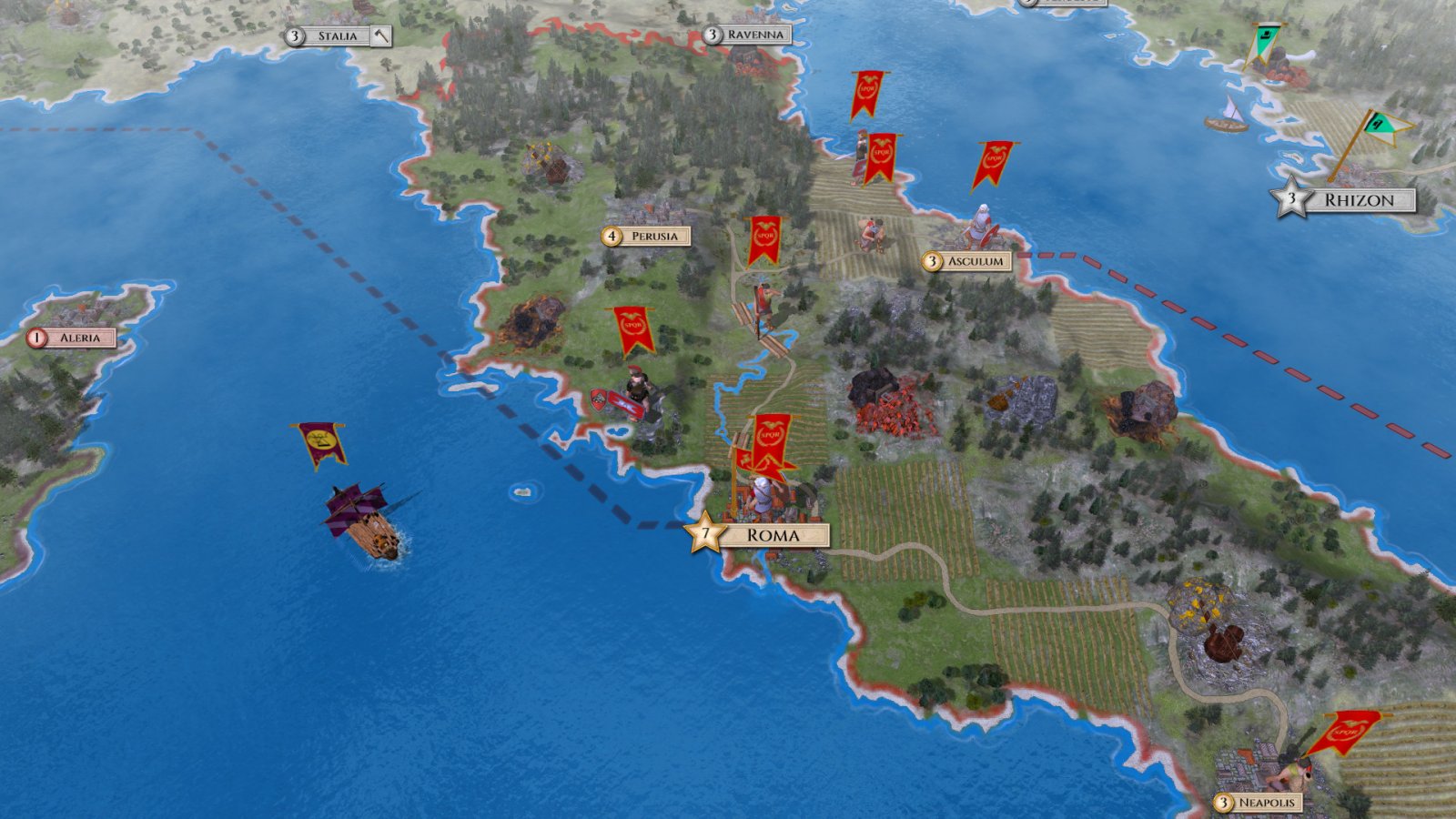Edited by: Tiffany Lillie
Bread and Circuses
Aggressors: Ancient Rome is a 4X strategy game developed by Kubat Software and produced by Slitherine Software. Set in ancient Rome, as the name suggests, you take control of any of the major cultures existent at that time. From Athens and Sparta to the Germanic tribes and the Ptolemaic Empire, all are represented. Having chosen your culture, you will then fight for supremacy across the Mediterranean, all the way to the Iberian Peninsula, with pit stops in northern Africa and the Middle East.
Veni, Viti, Vici
Aggressors: Ancient Rome feels like Civilization by way of Total War. Like Civilization, you control single-unit armies across the world map and found cities pretty much wherever you want. These cities, in turn, increase your sphere of influence and generate your more intangible resources like knowledge. Like Total War, however, cities are decentralized. Most of your production-increasing buildings are built outside of cities. Resources like iron and stone are confined to certain, predetermined spaces on the map. These map improvements can be attacked and captured just like cities but scarcely have upgrades. Cities themselves can be upgraded in multiple ways, either to defend against attackers and map events or to increase their output of resources.
Cities are also vital for the production of units. In order to build a specific unit, the city must first develop a specialization. Units require additional resources on top of this and can be further trained in the city that has their specific specialization. This builds an interesting choice between the immediate need of the unit on the battlefield versus the extra turns and resources it would take to train them to be stronger. Oftentimes, it is more valuable to spend those extra turns to train a unit, but when you're down to two cities and the whole Mediterranean is at war with you, sometimes sacrifices have to be made. You shouldn't throw units away on a whim, though. On difficulties Medium and above, your army has a shared morale pool per civilization. If you throw too many fights against Carthage, for example, future battles will be that much harder for you. When your morale sinks too low, you have the option to give your army a speech or consult oracles to try and increase it again. This is not a sure thing, however, and can wind up making the situation worse.
Crossing the Rubicon
Diplomacy also features heavily in Aggressors: Ancient Rome. No one culture is going to be able to produce everything in adequate amounts to sustain themselves. As such, you'll need to trade your way to victory. These trade routes are important as they increase trust between your two cultures. With enough trust, you'll be able to sign various treaties with them, giving you map information, ruling over them in a confederation, or annexing them outright. The impetus won't always be on you to initiate contact, though. Depending on how a culture feels about you, they may demand that you "cancel peace" with a culture they are fighting. Accept, and you'll be better friends; refuse, and you may anger them. The AI will also approach you with various trade and treaty proposals.
There are times, however, when diplomacy fails. War with other cultures allows you to enter their territory and capture it square by square. You'll need this in order to supply your troops within enemy territory. Should you lack supply on a tile your unit will lose health each turn. The lower a unit's health, the lower their attack and defense, making them more vulnerable to counterattack. As this is the Mediterranean, naval warfare also comes into play. Sea tiles have their own supply as well and naval units can run into storms while at sea. Naval units can also supply land units that would otherwise have no connection to your territory. This is useful for capturing enemy cities that you don't have a land route to.
Spoils of War
Much like the actual ancient Rome, you can fund your culture predominantly through war. When you capture an enemy city you obtain a healthy clutch of resources. However, capturing a city will also damage it, decreasing its production. Enough damage will halt production completely or even destroy the city outright. Fortunately, resettling a tile that had previously had a city on it is cheaper than settling an all-new city. Should a city survive your capture, you can spend resources and turns to repair it, depending on the extent of the damage. If you don't, your culture's overall happiness will go down. If it goes too low, people may abandon your cities, rebels may burn them to the ground, or whole cities may defect to opposing factions. Should you notice that an enemy city is unhappy, you can spend influence to speed their dissatisfaction and defection to your own side.
Aggressors: Ancient Rome advocates this sort of aggressive expansion. There are no penalties for having too many cities, and given that units require population to create, having more is always more beneficial. It definitely falls into the "play wide" sort of 4X game style. While there is an upkeep cost per city and per unit, there are many technologies and upgrades you can research to limit or completely remove these costs. Moreover, the more cities you control, the more land you control, and the more resource nodes you're likely to have. Having more cities also means you can replenish your army faster in times of war. There really is no benefit to "build tall" and many of the scenarios adjust the difficulty by altering the amount of starting cities you have.
Remaking History
Aggressors: Ancient Rome has two modes by default: the Mediterranean scenario and custom games. Custom games operate much like your standard game of Civilization, with all of the customization options you'd expect, from map size to climate. There are a handful of win conditions within custom games, from researching so many technologies to building the biggest army. You still have your standard global-domination victory, though. The real meat of the gameplay comes from the Mediterranean scenario. While you still have the same win conditions as in a custom game, you also have side objectives depending on which culture you chose. These can range from establishing a certain amount of trade routes to being at war with a specific culture to researching and building a specific technology. Each time you complete one of these objectives, the game will give you rewards. While these are often resources, they can also be units or map information. While they aren't necessary for victory, and you can certainly fail them, the bonuses these objectives give can pull you back from the brink.
If you know what you're doing, recovering your position can be rather easy. This seems to be by design, as certain map events can really place you in a bind. For example, during one of my Rome playthroughs, the plague ran rampant through my cities. This was relatively early on in the game, and I had not had the opportunity to research the counter to the plague. That didn't stop it from reducing the population of most of my cities down to one. Unable to build any more units, I had to quickly end all the wars I was in and focus on regenerating my population. Given that most improvements take two turns and none take more than four, I was able to bounce back within six or so turns. The short build times across the board tend to speed up play: while an average-length Civilization game can take me up to a week to finish, a game of Aggressors: Ancient Rome took me two afternoons. Granted, this was on Easy difficulty, and I had played a handful of games before to learn the ropes, but no game took me more than ten hours to see to the end.
A Crumbling Monument
Needless to say, Aggressors: Ancient Rome is mechanically deep and interesting. Unfortunately, the same cannot be said for its audio or visual design. While it is certainly adequate graphically, that's about the best I can say about it. Many of the models, particularly the human ones, look awkward and ill-defined. While it's enough to convey the differences between units and give you an idea at a glance as to what these units do, they look like something from a decade ago rather than a game from 2019.
The sounds don't fare much better. Much of the audio has a 1950s, black-and-white talkie quality to it. I struggle to define it well, but imagine as though the audio were recorded through a block of wood or a thin pillow. The music also seems dissonant with the setting and with the actions you're currently performing. The soundtrack operates like a jukebox, allowing you to stop and start it from a widget in the upper right of the screen. You can also skip through tracks as you like. If you let it run free, this means you can have a pounding action track playing while you're at peace with everyone and are just doing simple management and cleanup. Likewise, the more soothing tracks could be playing during a series of nail-biting fights. Moreover, most if not all of the tracks feature some sort of electronic or synthesized instrument. While I can't fault a small studio for lacking the resources to license or perform orchestral music, some of these tracks are very blatantly electronic.
The Verdict: Good
Aggressors: Ancient Rome is a fun, mechanically dense game held back a bit by subpar visuals and audio. Its faster pace lends to multiple, quick playthroughs and the amount of cultures on offer provides a large amount of replayability. If you can forgive the lack of visual polish, there's a lot here for a fan of the 4X genre.


